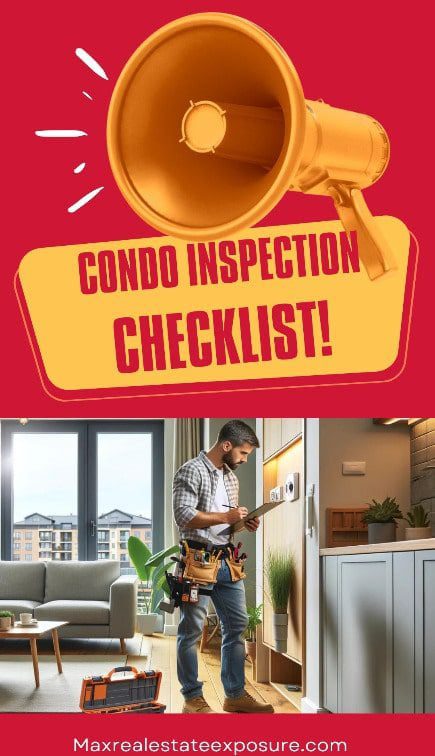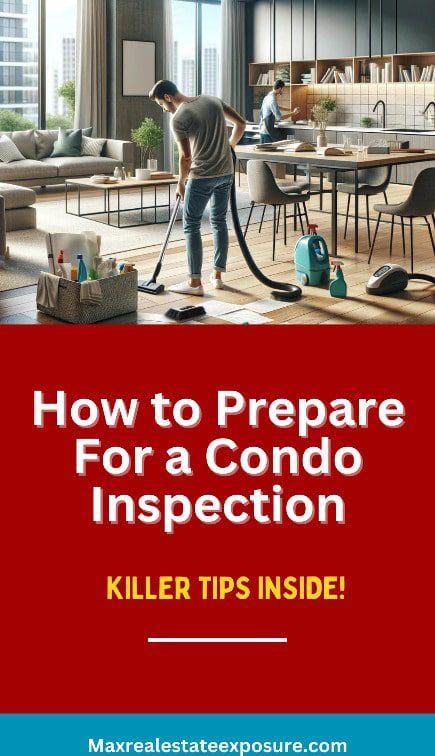 Preparing for a condo inspection ensures a smooth process and helps identify potential issues early.
Preparing for a condo inspection ensures a smooth process and helps identify potential issues early.
I will help guide you with sound advice on the following topics:
- How to prepare your condo for inspection.
- Common issues inspectors look for in condos.
- A detailed inspection checklist.
- Tips and potential costs associated with condo inspections.
From experience as a Massachusetts Realtor, I have probably attended close to a thousand inspections. It is a vital step in the home sale process. Many sales fall through due to inspection issues.
It’s wise to take the necessary precautions to prevent this from happening. Following my condo inspection checklist, you’ll understand the process and be better positioned to react.
If you plan on selling your condo, ensuring you don’t run into problems will be an excellent move.
Inspections are a significant hurdle to clear in a real estate transaction. Preparation is often the difference between being successful and watching in disbelief when the transaction falls through over something that could have been easily addressed.
Let’s dive into the steps necessary to prepare for a condo inspection.
Step 1: Understand the Inspection Process
After accepting an offer to purchase, the buyer typically sets up an inspection within 7-10 days. A professional inspector will conduct the assessment.
An inspection assesses the condition of your condo. The inspector will examine various aspects of the property, such as structural integrity, electrical systems, plumbing, and HVAC systems.
They identify problems affecting the sale or purchase and provide a comprehensive report detailing their findings. Understanding this process helps set realistic expectations and reduce anxiety.
A good home inspection checklist will help you understand everything an inspector looks for.
Step 2: Review Condo Documents
Gather essential documents, including:
- Maintenance records: Provide a history of any repairs or upgrades done to the condo.
- HOA bylaws: Help the inspector understand the rules and regulations governing the property.
- Recent inspection reports: Offer a baseline for comparing past and current conditions.
Having these documents ready not only aids the inspector but also demonstrates your organization and preparedness, which can positively influence the overall inspection outcome.
Step 3: Conduct a Pre-Inspection
Perform a thorough check of your condo. Look for obvious issues and address them before the official inspection. Part of your checklist for condo inspections should include the following:
- Checking for visible damage: Look for cracks in walls, water stains on ceilings, or signs of mold.
- Testing electrical outlets: Ensure all outlets and switches work properly.
- Running water: Check all faucets and toilets for leaks or weak water pressure.
Addressing these issues beforehand reduces the likelihood of them being highlighted in the inspection report, which can expedite the sale process.
When a potential seller asks me if they should have a pre-sale inspection, I usually answer in the affirmative. Pre-listing inspections can allow you to be better prepared and correct any deficiencies. By fixing problems beforehand, you increase the odds of a successful sale.
Remember, inspected homes give buyers confidence that a seller is not hiding problems. It will be worth it unless you sell the condo as-is to an investor.
Step 4: Clean and Declutter
Preparing a condo for sale is an excellent move.
A clean, clutter-free environment allows inspectors to access all areas easily, which helps them perform a thorough inspection. Remove unnecessary items from countertops, shelves, and storage areas.
Vacuum and mop floors, dust surfaces, and clean windows. A tidy space facilitates the inspection and makes a positive impression.
Step 5: Ensure All Areas are Accessible
Ensure inspectors can access every part of your condo, including:
- Closets: Remove any items blocking access to electrical panels or plumbing shut-offs.
- Utility rooms: Clear paths to water heaters, HVAC units, and other critical systems.
- Crawl spaces and attics: If applicable, ensure these areas are easily accessible.
Ensure the basement walls are free of your stuff and accessible for the inspector. Otherwise, they cannot check the walls for cracking or moisture or access the sills, a vital structural integrity component.
Accessibility is crucial for a comprehensive inspection. Blocked areas might lead to incomplete reports or delays.
Step 6: Test All Systems
Check that all systems are in working order. This includes the following:
- HVAC systems: Ensure heating and cooling systems operate efficiently. Ensure all of your filters are changed, as they can impact the system’s proper operation.
- Plumbing: Run water in all sinks, showers, and tubs. Check for leaks or blockages.
- Electrical: Test lights, outlets, and circuit breakers.
If any issues are found, consider hiring a professional to address them before the inspection. Functioning systems indicate proper maintenance and reduce potential red flags.
Step 7: Inspect Safety Features
I recommend you test smoke detectors, carbon monoxide detectors, and fire extinguishers to ensure they are functional and up to date. If needed, replace detector batteries and check expiration dates on fire extinguishers.
Safety features are critical in inspections and must meet current standards.
Step 8: Repair Minor Issues
Fix minor problems like:
- Leaky faucets: Repair or replace faulty faucets.
- Loose tiles: Reattach or replace loose or broken tiles.
- Damaged screens: Replace or repair window and door screens.
From experience, minor repairs can make a big difference in the inspection report. They show that the property has been well-maintained and can prevent minor issues from being noted as more prominent concerns.
The more things you can do to show pride of ownership, the better.
Tonya Peek with The Tonya Peek Group encourages all sellers to correct minor issues on a home inspection report:
“Is a leaky faucet going to keep you from selling? It shouldn’t. And neither should other small or minor issues. If you know about a problem with the condo that can’t be fixed, it’s best to buckle down and get it done rather than hope the buyers don’t notice. If buyers see that the little things are not fixed, they may wonder if big things are not taken care of. Don’t let buyers be wary of you. If there is a known issue, especially a minor one, it’s best to take care of it before you list.
Many sellers may say the opposite; a minor issue shouldn’t let buyers stop them from buying the home, but in my experience, buyers are much more likely to think that sellers are unwilling to fix significant issues that they may not know about if the door squeaks, the hole in the door never got patched, or the tub faucet is loose. Just get it done. You’ll reap better rewards when you do list.”
Step 9: Don’t Forget About The Exterior and Common Areas
When the homeowners association maintains your condo’s exterior, it can be easy to forget about it. However, the inspector won’t. They will look it over along with any common areas or buildings.
Remember that if these items are not maintained, they reflect poorly on the condo association. Look over the exterior carefully for defects and address them if you can.
Your checklist should include reviewing the common areas, such as the lobbies and hallways, and any perks, like swimming pools. While you may not be able to address these issues, you can request with the HOA.
Checklist for Condo Inspection Preparation
-
 Gather condo documents: Maintenance records, HOA bylaws, and recent inspection reports.
Gather condo documents: Maintenance records, HOA bylaws, and recent inspection reports. - Clean and declutter: Ensure a tidy environment for easier access.
- Ensure accessibility to all areas: Closets, utility rooms, crawl spaces, and attics.
- Test HVAC, plumbing, and electrical systems: Check for efficiency and functionality.
- Check safety features: Smoke detectors, carbon monoxide detectors, and fire extinguishers.
- Repair minor issues: Leaky faucets, loose tiles, damaged screens.
Here is a detailed list of tips for home inspection preparation.
Common Issues Inspectors Look For in Condos
Remember, most buyers don’t purchase as-is unless it is an extreme seller’s market.
Inspectors commonly check for the following issues:
- Structural Integrity: Inspectors look for cracks or damage in walls, ceilings, and floors. They also check for signs of settlement or foundation issues, which can indicate serious problems.
- Electrical System: Common concerns include outdated wiring, faulty outlets, and insufficient electrical capacity. Inspectors also check for proper grounding and the condition of the electrical panel.
- Plumbing: Inspectors check for leaks, water pressure issues, and outdated plumbing materials. They also look for signs of water damage, such as stains or mold around fixtures.
- HVAC System: The efficiency and condition of heating, ventilation, and air conditioning systems are assessed. Inspectors check for proper installation, maintenance records, and potential issues with ducts or filters.
- Mold and Moisture: Inspectors look for water damage, mold, or mildew signs. These issues can indicate more extensive problems, such as leaks or poor ventilation, and affect indoor air quality. Selling a home with mold is not wise, so ensure you address it if you have this problem.
Tips for Making the Inspection Process Easier and Smoother
- Have Your Realtor Present During the Inspection: Part of excellent representation is having your listing agent attend the inspection to answer any questions and provide access to all areas. Their presence allows you to understand any potential concerns without exaggeration. I recommend you attend if you sell a condo without a real estate agent.
- Be Prepared: Have all necessary documents and information ready for the inspector. This includes maintenance records, recent repairs, and any warranties for appliances or systems.
- Cooperate: Follow the inspector’s instructions and provide any requested information promptly. Cooperation helps the inspection go smoothly and quickly.
- Stay Calm: Remember that the inspection aims to identify potential issues, not to fail or pass the property. Use the findings as an opportunity to make informed decisions.
Potential Costs Associated with Condo Inspections
Condo inspection costs vary based on location, size, and complexity. Here are some potential expenses to consider:
- Standard Inspection: Typically costs between $300 and $500. This includes a general assessment of the property.
- Specialized Inspections: Additional inspections for specific issues (e.g., mold, radon) can cost between $100 and $300 each. These are recommended if there are concerns about particular problems.
- Repairs: Costs vary widely based on the extent and nature of the issues found. Budget for potential repairs that might be necessary after the inspection report.
Conclusion
Preparing for a condo inspection involves several steps, from reviewing documents to fixing minor issues. Following a sound condo inspection checklist can ensure a smoother process and address potential problems early.
About the Author: Bill Gassett, a nationally recognized leader in his field, provided the above real estate information on a checklist for preparing for a condominium inspection. Bill has expertise in mortgages, financing, moving, home improvement, and general real estate.
Learn more about Bill Gassett and the publications in which he has been featured. Bill can be reached via email at billgassett@remaxexec.com or by phone at 508-625-0191. For the past 38+ years, Bill has helped people move in and out of Metrowest towns.
Are you thinking of selling your home? I am passionate about real estate and love sharing my marketing expertise!
I service Real Estate Sales in the following Metrowest MA towns: Ashland, Bellingham, Douglas, Framingham, Franklin, Grafton, Holliston, Hopkinton, Hopedale, Medway, Mendon, Milford, Millbury, Millville, Natick, Northborough, Northbridge, Shrewsbury, Southborough, Sutton, Wayland, Westborough, Whitinsville, Worcester, Upton, and Uxbridge Massachusetts.


 Gather condo documents:
Gather condo documents: